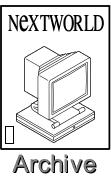 |  |  |  |  |  |  |
| | | | |

|

|
|
| |
March 1992 |
|
 |
|

|
 |
DTP "engine" proposed
by Simson L. Garfinkel
Waltham, MA: Archetype, a seven-year-old software venture, has announced a NeXTstep "document engine" designed to be the basis for modular desktop publishing applications.
The Archetype engine is like a document database system, said Paul Trevithick, president and CEO of the company, which is based here. The engine runs as an independent process on a NeXTstation and manages all aspects of the document's internal data structure. For example, the engine reads the document into memory from the disk, manages all changes to the document, and generates the PostScript necessary to display the document on the computer's screen.
But the engine lacks a user interface and tools to allow direct manipulation of the document itself. Those tasks are performed by separate applications that communicate with the engine through Mach messages.
By design, more than one tool can be running the computer, each communicating with a single engine and editing a different aspect of the document at the same time. For example, a user might have one program to control page layout, another for editing text, and a third for manipulating photographs embedded in the document.
"Applications will be smaller, focused on a specific kind of functionality, not 10,000 functions in a box," Trevithick predicted.
The two-program approach extends naturally to a networked environment, Trevithick said. If two people on the same local-area network try to edit the same document at the same time, the two engines find each other, "hook up," and from that point maintain a unified view of the single document.
By making the Archetype application programming interface (API) public, Trevithick hopes to encourage third parties to develop tools built upon the engine. To give third parties a start, Archetype will be selling an Archetype Developer's Kit, containing a working engine and the source code to a page-layout program, for $995. End-user pricing for the engine has not been set.
"This is a totally different approach" from existing DTP systems, said Trevithick.
The engine is modular and extensible, said Trevithick, so that developers can add their own custom objects that would be put into Archetype documents. The design also allows customers to change the engine's internal objects as well.
"If you had a custom hyphenation and justification or line-break algorithm, you could slide Archetype's out and yours in," Trevithick said.
The Archetype engine is based on Xaviar, an MS-DOS page-layout program that Archetype has been developing for the past seven years. Because Xaviar is written entirely in Objective-C, it was easy to port the program to NeXTstep, said Kenneth A. Bonnin, a software engineer with the company.
"In coming to the NeXT, we had a real opportunity to evaluate our design, shake it up, and put it back together in a way that makes sense with today's technology," he said. "This is an idea that Paul has had for quite some time, but the technology wasn't there until this machine came along."
|
|